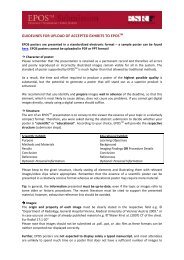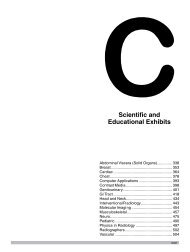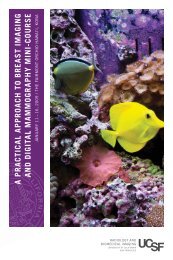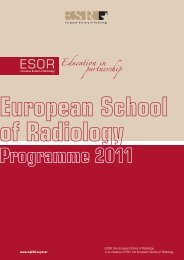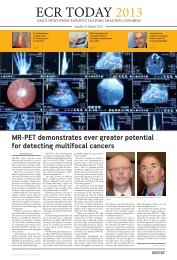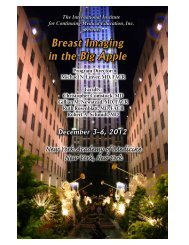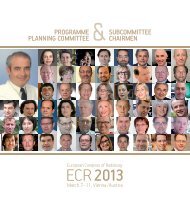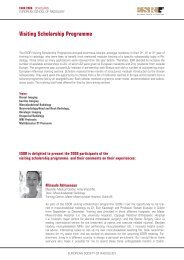ECR 2013 â Final Programme - myESR.org
ECR 2013 â Final Programme - myESR.org
ECR 2013 â Final Programme - myESR.org
- No tags were found...
Create successful ePaper yourself
Turn your PDF publications into a flip-book with our unique Google optimized e-Paper software.
Postgraduate Educational <strong>Programme</strong>08:30–10:00 Room QSpecial Focus SessionSF 4b Justifying CT in paediatric radiology08:30A-105 Chairman‘s introductionC. Owens; London/UKSession Objectives:1. To become familiar with the importance of CT justification andoptimisation.2. To understand the evidence base for concern.3. To become familiar with realistic alternatives to CT.08:34A-106 How should CT be optimised?W.A. Kalender; Erlangen/DELearning Objectives:1. To become familiar with the dose levels currently encountered inpaediatric CT.2. To become familiar with new developments towards dose reductionin CT.3. To learn about tools for assessing <strong>org</strong>an dose and effective dosevalues.08:56A-107 When, how, and why I perform CTC. Owens; London/UKLearning Objectives:1. To become familiar with the concept of CT ‘fit for purpose’.2. To appreciate the role of CT in paediatric body imaging.3. To become familiar with suggested parameters for use of CT incardiothoracic imaging, describing risks and benefits.09:18A-108 Why and when CT does not need to be performedM. Claudon; Vandoeuvre-les-Nancy/FRLearning Objectives:1. To become familiar with alternative imaging methods to replace CT.2. To appreciate the advantages and disadvantages of these alternativemethods of imaging.3. To become familiar with a practical model for CEUS and MRI inbody imaging.Panel discussion:09:40 Do we have guidelines for paediatric CT?Do we have alternatives?10:30–12:00 Room AInteractive Teaching SessionE³ 520a Pitfalls in abdominal imaging10:30A-109 A. LiverV. Vilgrain, M. Ronot, A. Kerbaol, O. Bruno; Clichy/FRLearning Objectives:1. To learn about morphologic changes in the liver observed in noncirrhoticdiseases.2. To understand imaging features enabling distinction between intraand extrahepatic tumours.3. To become familiar with liver lesions mimicking liver tumours.11:15A-110 B. Pancreas and bile ductsR. Manfredi; Verona/ITLearning Objectives:1. To understand the MRI technique for evaluating the pancreaticparenchyma, the pancreatic duct system and the biliary tree, thefunctional assessment following secretin stimulation.2. To appreciate the signs in MR imaging of the pancreas and bile ducts.3. To understand the diagnostic imaging criteria useful for differentialdiagnosis.10:30–12:00 Room BESR meets SpainEM 1 Imaging: essential tool fromdiagnosis to treatmentWelcome by the ESR President:G.P. Krestin; Rotterdam/NLPresiding:C. Ayuso; Barcelona/ESJ.I. Bilbao; Pamplona/ES10:30A-111 IntroductionC. Ayuso; Barcelona/ESSession Objectives:1. To discuss the role of imaging techniques in different clinicalscenarios where radiologists are key, from diagnosis to treatment.2. To present technical imaging innovations that assist the diagnosis,treatment and follow-up in three different clinical scenarios:ischaemic stroke, aortic aneurism and hepatocellular carcinoma.3. To present specific clinical advantages and results of themultimodality approach.10:35A-112 Ischaemic strokeJ. Macho; Barcelona/ESLearning Objectives:1. To discuss the clinical and neuroradiologic implications of an earlydiagnosis. Evaluation of CT and MR diffusion/perfusion in patientselection for endoarterial treatment.2. To understand the rationale behind mechanical endoarterialreperfusion of acute vascular occlusion.3. To analyse the short and medium term results of a regionalprogramme for acute stroke treatment after three years.10:55A-113 Interlude: Spanish radiologists: open to the worldE. Fraile Moreno; Madrid/ES11:00A-114 Aortic aneurismsJ.J. Martínez Rodrigo; Valencia/ESLearning Objectives:1. To understand the role of imaging modalities in diagnosis andendovascular treatment of aortic aneurisms.2. To learn about the role of 3D imaging techniques to assist theendovascular treatment of aortic aneurisms.3. To appreciate the role of imaging modalities in evaluating thecomplications of endovascular aortic repair.11:20A-115 Interlude: Radiologists and Spanish winesL. Martí-Bonmatí; Valencia/ESLearning Objectives:1. To understand the influence of the country, the climate and thesituation in the quality of wines.2. To learn about Spain‘s characteristics that influence the wine quality.3. To appreciate why the soil (and by extension the terroir) is soimportant.11:25A-116 Hepatocellular carcinoma: the BCLC approachM. Burrel; Barcelona/ESLearning Objectives:1. To understand the clinical implications of an early diagnosis, whenthe lesion is small and asymptomatic.2. To learn about the rationale behind the current guidelines for modeltreatment options.3. To appreciate the spectrum of locoregional therapies for HCC frompercutaneous to intravascular approaches.Panel discussion:11:45 Is the multidisciplinary environment the natural way todevelop excellence and leadership in clinical imaging?A-105 – A-116Friday165




